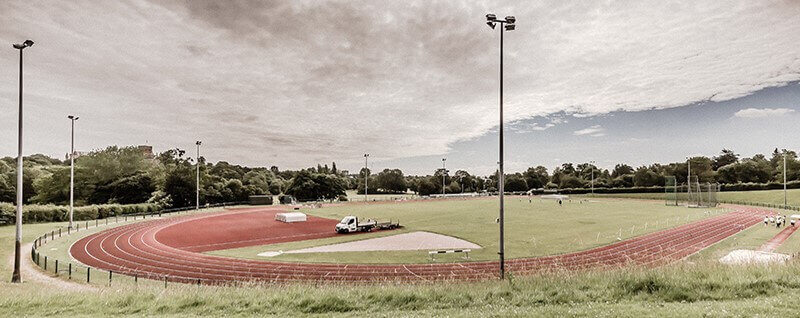Using the drop jump to improve sprinting speed by increasing your leg stiffness.
If you take a slow motion view at any top-class sprinter whilst in full-flight you’ll see what appears to be minimal knee flexion of the stance leg when its directly under the body.
When you consider that an elite sprinter’s ground contact time is around 0.08 seconds at maximal velocity, and within this time they will overcome as much as three times body weight as they reach speeds nearing that magical 30mph. This shows the importance of leg stiffness, without it, sprint velocity would not be as high.
In a sports science review on the importance of leg stiffness, the following definition and way of assessing stiffness was provided: “Human running and sprinting can be modelled as either a spring-mass model or multiple springs in series. A force is required to overcome and stretch or compress the spring and thus the stiffness can therefore be calculated as a ratio of this force to the change in spring length.”
Leg stiffness requires a very strong eccentric reaction and then followed immediately by a super fast concentric action – however, to achieve this there should be virtually no delay between the “stretch/eccentric” and “reflex/concentric”. These muscular actions constitute what is referred to as the stretch-shortening cycle “SSC” and are key to plyometrics. This response in relation to our top sprinting speed, produces the dynamic extension of the ankle, knee and hip joints (triple extension).
Research: Leg stiffness and training methods
There are numerous methods to develop Leg stiffness. These include training with weights, the fore mentioned plyometrics, sprinting itself and resisted running, such as heavy sled-towing. However, when we take a look at the research, it appears that actually developing leg stiffness via these various training methods is complex and not straight forward as we would hope. In fact, some of the training methods actually contribute to different facets of our speed development.
Sports Science researchers looked at the inter relationship between leg stiffness and leg power as they related to sprinting performance. Eleven post-pubescent subjects aged between 15-17 took part in the study both acceleration and maximum speed were analysed during a 40m sprint. Leg power was further achieved using a treadmill equipped with speed and force transducers from which linear/horizontal power was calculated. A standard hopping test was also used utilising a force plate and leg stiffness calculated using flight and contact times.
What the researchers discovered was that forward leg power was highly correlated with both acceleration and maximum velocity sprinting. However, the results of leg stiffness testing indicated that it was more correlated with Top Speed “leg stiffness as calculated from hopping was significantly correlated with maximal velocity but not with acceleration”.
In another study on the subject, New Zealand researchers studied the ground-reaction forces (GRF) involved during a sprint acceleration. Thirty-six male athletes performed max sprints with sensors placed at the 16m mark. The research showed that the faster-accelerating athletes displayed less vertical impulse and much more horizontal force as a ratio of application.
These findings were agreed and furthered by researchers who specifically analysed the performances of 19 regional to national-level sprinters over 100m. They also wanted to asses and consider the importance of leg strength and stiffness over three distinct sprint phases of 100m: being acceleration 0-30m, Top Speed 30-60m and Speed Endurance 60-100m, using video analysis. They matched performances based on leg strength using a concentric half-squat – a counter-movement jump and single leg hopping.
As per previous assessments, the hops were used as a predictor of the athletes leg stiffness. The times achieved by the athletes ranged from 10.72-12.87. Specifically, it was discovered that the gym favourite of the concentric half-squat was related most strongly to the mean speed of each phase. The counter-movement jump was mostly related to the acceleration phase 0-30m, while the afore mentioned hopping test was the best predictor of the two last phases.
From the research it is extremely clear to deduce that varying training methods (weights, sleds, plyometrics) results in different training effects to improve different aspects of leg stiffness and sprint speed.
We must all therefore be mindful to train in differing ways that will optimise all phases of our sprint, while enhancing our leg stiffness. As an example, using heavy-load concentric squats to develop all areas and specifically the first few steps of acceleration and then sled-towing the remainder of the acceleration (transition) phase and plyometrics to further enhance top-end speed.
The role of drop jumps in developing leg stiffness
Drop jumps are designed to enhance plyometric ability. A drop jump is simply step off of a raised platform and immediately upon landing taking off again to achieve as a higher height as possible.
Crucial to the optimum performance of a drop jump is the transition between the eccentric (landing) and concentric (jump) parts as we mentioned earlier this is the SSC. This is the emphasis of the jump in order to improve leg stiffness.
Sports science researchers looked specifically at this method of training and its effects on rugby players. They were tested for ability to 0-10m acceleration and for top-end sprint speed using a flying 10m-sprint (a run where they had reached top-speed) and physical strength (using a three repetition maximum squat), and others to assess metrics.
In keeping with most of the other findings of similar research mentioned above it was discovered that leg stiffness and drop jump performance was highly related to the flying sprint 10m time.
It’s complicated
As shown Leg stiffness, the “human spring response”, can be trained by using many of the varied methods in the pursuit of greater sprint speed. It’s crucial that we as athletes ourselves and as coaches realise that the different methods affect leg stiffness can create different “sprint responses” (sled-towing will improve acceleration more than top-end speed, for example). Plyometric exercises appear to the be key exercise to improve leg stiffness. For example, we would expect that an athlete who has good hopping and drop jump ability will have good high-end sprint capacity and leg stiffness.
Now of cause drop jump are not a modern thing, in fact the great coach Verkhoshanksy introduced this as shock method many years ago. His paper is attached.
Shock Method Plyometrics


